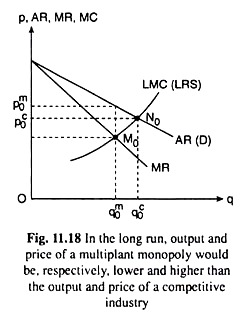There is an important point of similarity between the long-run equilibrium of a perfectly competitive industry and that of a multi-plant monopolist. In both the cases, individual plants are operated at the minimum long-run and short-run average cost.
On the other hand, the difference between the two types of long-run equilibrium will be apparent if we assume that the individual plants of the multi-plant monopolist are the plants of the individual firms in the perfectly competitive industry. Then the LMC curve of the multi-plant monopolist would be the same as the long-run supply (LRS) curve of the perfectly competitive industry under increasing cost conditions.
This is because the LMC curve has been obtained on the basis of the assumption that each plant under monopoly is operating at the minimum point of its LAC curve. Therefore, the long-run equilibrium of the perfectly competitive industry is obtained in Fig. 11.18, at the point of intersection, N0, of the AR(D) curve and the LMC (LRS) curve.
On the other hand, the long-run equilibrium of the multi-plant monopolist would be obtained at the point of intersection M0 between the MR curve and the LMC curve in Fig. 11.18. Since the point N0 lies upward towards right of point M0, the competitive output, qc0, would be larger than the monopoly output, qm0, and the competitive price, pc0, would be smaller than the monopoly price, pm0.
ADVERTISEMENTS:
Since the competitive output would be larger than the monopoly output, it may be presumed here that the number of firms under perfect competition would be larger than that under monopoly.
Also, in Fig. 11.18, since for each firm under perfect competition LAC = LMC = N0qc0 = the price of the product (= pc0), the firms under perfect competition would be able to earn only the normal profit. On the other hand, in the case of multi-plant monopoly, we obtain LAC = LMC = M0qm0 < the price of the product (= pm0). Therefore, here, the firm would be able to earn more than normal profit.
We may conclude from the above analysis that both the multi-plant monopoly and the perfectly competitive industry are characterised by minimum average cost of production in the long run.
ADVERTISEMENTS:
But in comparison with the latter, the former would sell a smaller quantity, charge a higher price, and operate fewer plants, and while the latter is characterised by normal profit, the former would be able to earn more than normal profit. Therefore, here also, as in the case of a single-plant monopoly, social welfare level tends to be higher under competition than under monopoly.

